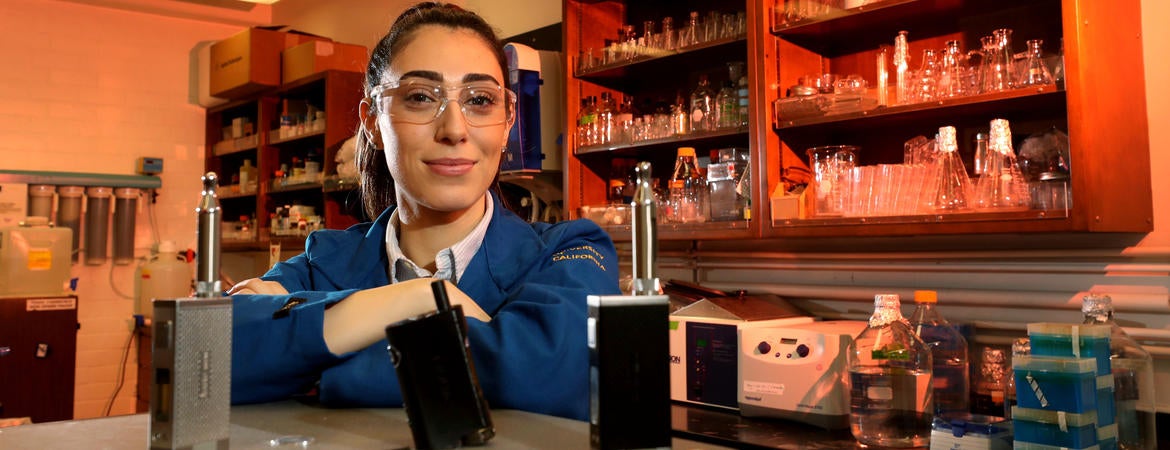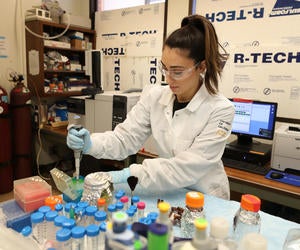
You don’t want Careen Khachatoorian for a sister. Not if you smoke, you don’t.
Careen’s older brother is trying to conceive a child with his partner. A typical text to her smoker-brother includes a link to a sins-of-smoking article, and reads like this:
“See? Pregnant mothers have a greater chance of delivering a child with ADHD if they are exposed to smoke.”
Or…
“See? Cigarette smokers don’t produce as much sperm.”
Khachatoorian, who is a sixth-year Cell, Molecular, and Developmental Biology graduate student, isn’t shy about propagating the long-known dangers of smoking. But her present research focus is on a similar danger, the gravity of which is still unfolding. That’s the potential dangers associated with electronic cigarettes, or e-cigarettes.
Marketing campaigns have likened exhaled e-cigarette aerosol to water vapor, but Khachatoorian says that’s a gross mischaracterization—“It’s far from that.” The liquids that produce the exhaled aerosol include nicotine, propylene glycol, glycerin and – allegedly – formaldehyde.
Previous research by UCR’s Prue Talbot Lab – of which Khachatoorian is a member – has demonstrated higher levels of metal particles in e-cigarette aerosol than is found in cigarette smoke. The aerosol contains metals including tin, silver, iron, nickel, and aluminum; many of which are known to cause respiratory disease.
The sixth-year graduate student’s area of study is pinpoint-specific: the residue left behind by e-cigarettes. The residue is called electronic cigarette exhaled aerosol residue, or ECEAR, and two recent, published papers Khachatoorian has authored attest to its presence in the homes and businesses where electronic cigarette use occurs.
In one of the studies, Khachatoorian found the electronic cigarette aerosol from a vape shop left detectable traces of ECEAR on cotton and terrycloth towels placed inside a nearby business. In another study, she looked at fabrics left inside vape shops and vaping homes, also finding ECEAR. The film left behind is sometimes visible, she said.
Talbot said Khachatoorian is the first to demonstrate the transfer of ECEAR from vape shops, and the increase in residue over time.
“Her work clearly indicates that we need more studies of this type and a better understanding of how e-cigarette chemicals are distributed in indoor environments and what their health effects may be,” Talbot said. “As is often the case, these products were introduced without much background research on them.”
For her part, Khachatoorian doesn’t want vapers to learn how dangerous their habit is in the same way smokers did, over the course of generations.
“For a long time, people didn’t know the dangers of cigarettes. Now, we know the dangers,” Khachatoorian said. “Who knows—10, 20 years from now—what e-cigarettes will have been found to cause.”
Talbot said Khachatoorian is well-poised to communicate those dangers, with a knack for articulating her work to others, “scientists and non-scientists alike.”
It’s a sense of purpose that appeals to Khachatoorian, whose parents immigrated to the U.S. from Iran.
“I believe, if my parents moved halfway around the world for a better life, I should take advantage of that,” she said.
As she and other researchers continue their work, Khachatoorian said the findings already hold an important lesson. That is, those who use electronic cigarettes should consider better ventilation options and clean the surfaces in their homes—particularly if they have young children.
Follow this link to read about e-cigarette myths, and the work of the Prue Talbot Lab.




